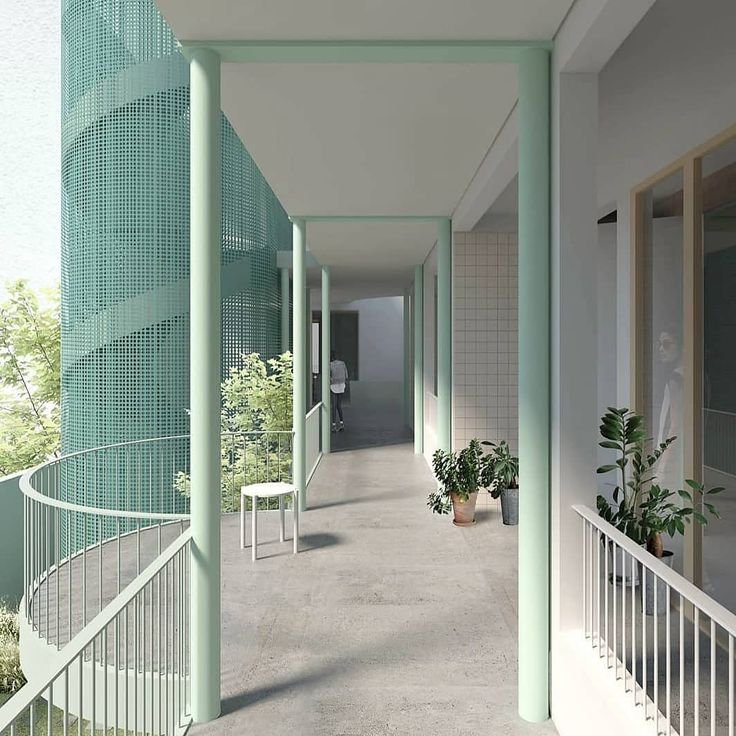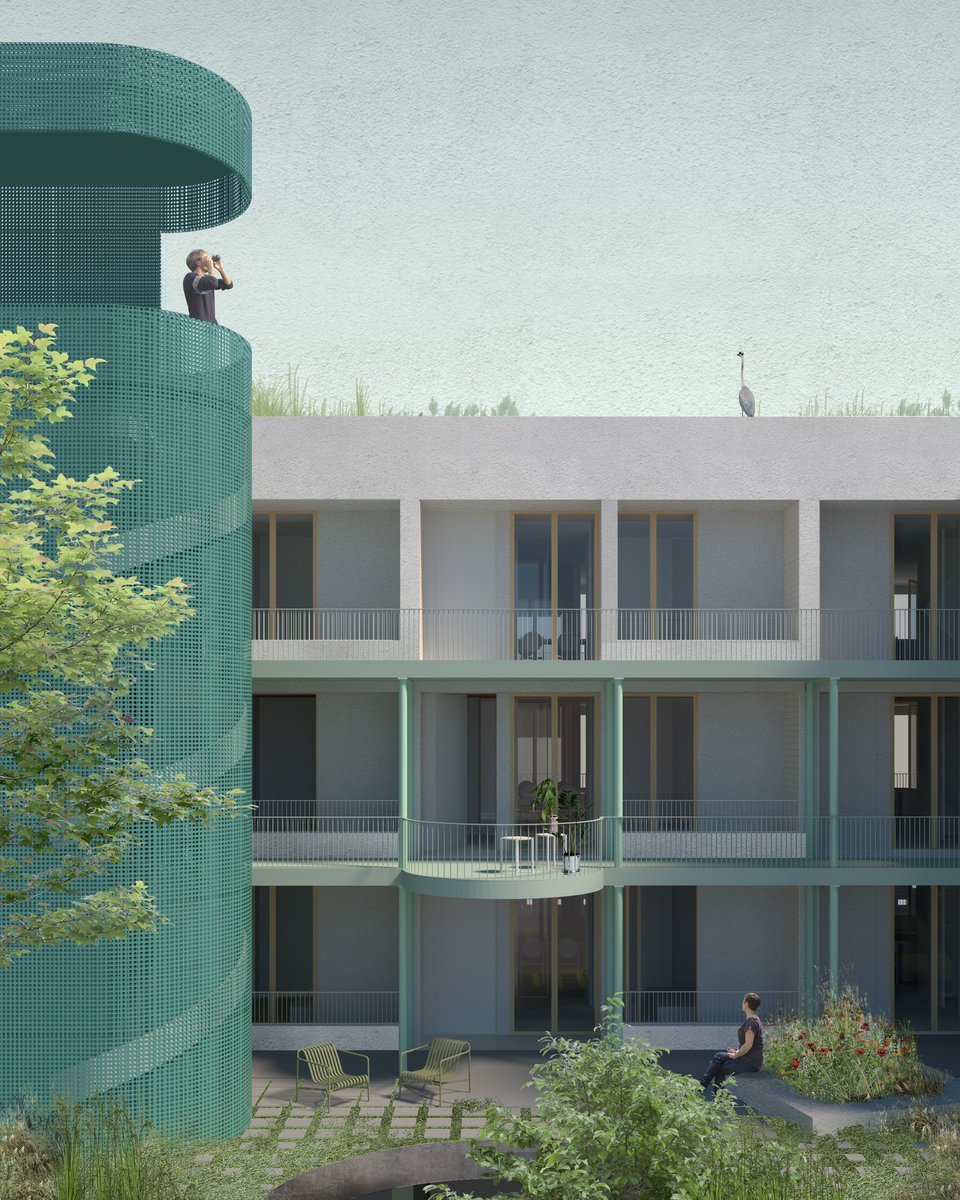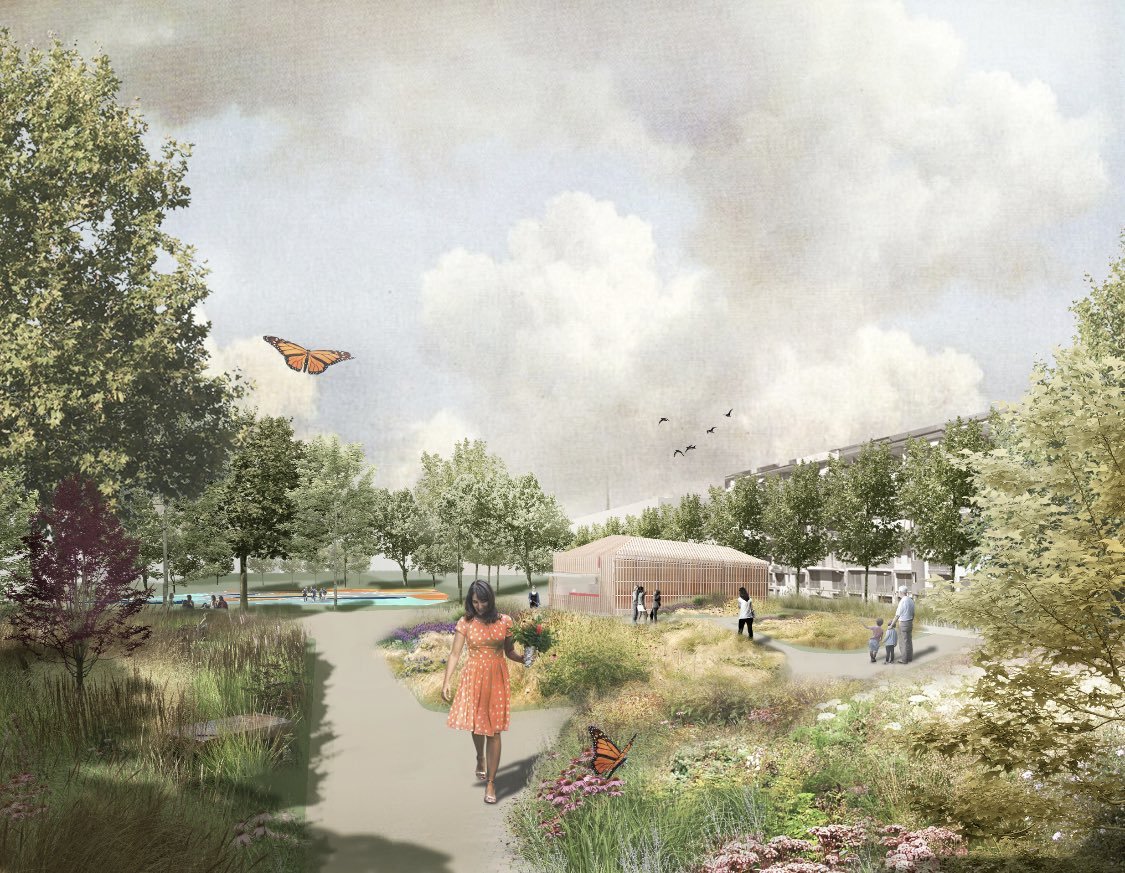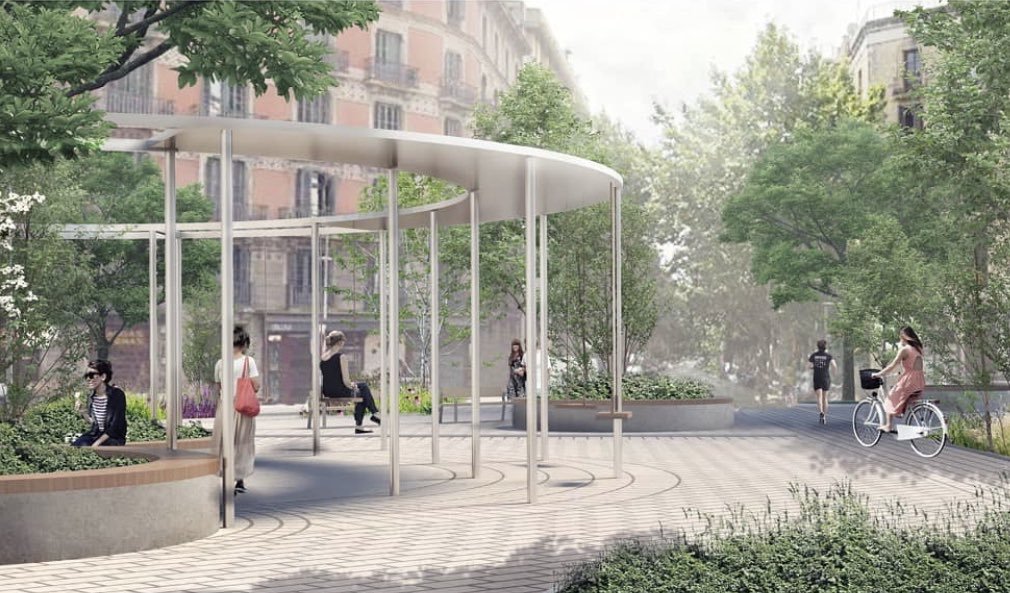Returning Nature To The City with Barri Studio
A conversation with Jordi Barri of Barri Studio in Barcelona for the Green & Healthy Places podcast episode 038 on sustainability and wellbeing in real estate and interiors.A conversation with Jordi Barri of Barri Studio in Barcelona for the Green & Healthy Places podcast episode 038 on sustainability and wellbeing in real estate and interiors.





Conversation highlights:
Everything is interconnected. So at the end, the relationships between plants, insects, and even humans, are crucial for our work, especially in an urban surrounding.
We created a garden of pollinators that allows insects to gather and colonize.
When we see butterflies in the neighborhood it means that we are recovering, and those vegetation communities are working well. It's like a biodiversity parameter for a healthy environment.
In response to climate change, landscape architects have to design with nature, not against it.
We did a study of the bird species of the area and their migration behavior then designed a rooftop with plant communities suitable for those nesting birds.
Nature is complex, vivid, random, diverse...
With our designs we want to bring back wild, uncontrolled nature into our cities - it’s much better for the soul.
Matt Morley
Jordi - Great to have you on the podcast. You grew up surrounded by plants, it's obviously in your DNA, your family had a plant nursery in Catalonia. I wondered how you think now about that experience, how it's influenced you, and the knowledge that was handed down to you from the previous generation generation?
Jordi Barri
Well, yeah, I grew up in a plant nursery, it was from my grandfather, and my father and now is run also by my brother. The botanical names, usually that's something very funny, even with my friends, because they were are always joking about how I know all the right plant names, it is just like a lexicon that has always been there for me.
I remember when I was a kid, my father, not forced me but let’s say ‘obliged me’ in the summer to work with him, since I was about 10, so every summer for one month, we had to be in the nursery working! At the end, it has been very much influential in in me, even, I remember those winters where we went to the nursery, with the Christmas trees, and we had to deliver them around the neighborhood. All of that helped me now to understand much more about how those plants evolved, how they behave, and so on.
Matt Morley
It's interesting, hearing your response, it occurs to me that there's a tangible difference between having parents with their own business versus someone who may be running a company, but it's not their company. For the kids, it’s a completely different result in may ways.
So clearly, that knowledge of landscaping and biophilia (connection to nature) is built into your heritage but how have you built upon it to create your own particular style today?
There is a lot of thinking behind the plant strategies that you put forward. In addition to aesthetics, there's this functional side, clear ecologically inspired concepts and strategies in fact. Can you talk to us a bit about that, about how you try to promote biodiversity, for example, via specific combinations of plants to almost giving your projects a higher purpose beyond just sort of decorative landscaping?
Jordi Barri
Yeah, well, at the end, we are very much interested in our landscape designs not being static , we like to go deep in understanding the relationships between those plans and within the plant community we design to see how they can all work together.
So in order to solve problems for example, when you have trees that are attacked by aphids, we can create a plant community that captures the attention of ladybugs that also serve to attack those aphids.
It's a kind of symbiosis that we’re trying to achieve here, in order to bring something more than aesthetics, for example, to understand how certain plants can help sequester carbon, capturing CO2. It's trying to work a beyond the aesthetics, and going more into an ecological approach based around functionality.
Biophilia
When we bring that into the city, we don’t just bring natural beauty but additional ecological benefits too. Everything is interconnected. So at the end, the relationships between plants, insects, and even humans, are crucial for our work, especially in an urban surrounding.
Matt Morley
Rewilding
Sounds quite similar to some of the rewilding projects that are going on in the UK, for example, where people, landowners often are looking to reintroduce certain species that have become extinct, as a way to promote greater diversity in the animal world around them and find that balance that perhaps has been lost due to the impact of industrialization and basically humans on the planet.
Landscapes in placemaking
So let's dig into one of your projects as an example, because I think designing a garden or creating private spaces is one thing, and we can cover that later. But I’m really interested in the role that landscape designers can play in, let's call it like placemaking. Public squares, places that make up the urban fabric of a city, that in a sense, you're designing and creating these green spaces, right, so you're bringing some greenery back into urban lives that way.
I was looking at the town square project you did in in Santa Eulalia. I think you're starting that one next year. Can you describe the different components that go into that type of project?
Jordi Barri
Designing urban green spaces
Well, yeah, well, it's a kind of a probably Plaza divided in different areas. And also, what is characteristic about these are its organic forms that it's more rounded. What we also wanted to recreate was much more about the sensation of the memory that the people of the town have when they go to the river, and how we can try to bring that sensation into that urban Plaza.
So, at the end, it was like, divided in like if we call like three different areas, that one is called like a dense wood. So where we plant a dense wood that recreates a little bit the the woods and the trees that we have in those areas surrounding that town.
Playgrounds for kids
Then there is a flexible, performative surface, where those different activities can happen. And also, there is a kids area - almost a must when you do a public park or plaza, because at the on the end, they are the main users and so we have to bring in the functionality of the playgrounds, but also a more didactic angle for them, so that they start to understand how to deal with with nature they're so we usually those games that we plan the plan for them are in that case, are made from robinia wood instead of plastic.
Matt Morley
Nature in urban design projects
Then you have other projects, such as the one in in Blanes also starting in 2022. What sort of techniques or strategies can you use to create a small hub, like a nature-oriented meeting place for the local community? How does that how does landscaping connect with that bigger strategic concept of creating a meeting place for locals and promoting a sense of community for the people who live in that area?
Jordi Barri
Well, it's true that in that case, in that park, there was a strong Neighborhood Association, and it was already like a kind of a meeting point for them, but it was totally disrupted and not very pleasant. So, our strategy there, obviously, because we are focused on ecological aspects was to create a topographical movement. And with that, a little slope, we collect all that rain water, towards what we call a bio swale.
And that bio swale acts like a spine, at the end becomes like the place where you can walk, and the different zones of that parks are attached to that spine.
Biodiversity
So in another aspect, in terms of our ecological approach - we created a garden of pollinators that allows insects to gather and colonize.
We have all seen in the pandemic how parks have become like a very important place, even for healing minds and for the healthy health of the people. So I think that by combining these two aspects, like the beauty and the ecological as we always try to do, people will will be pleased to gather there and enjoy the park.
Matt Morley
Biophilic design
I think that's where what you do starts to overlap with what I do in terms of creating green indoor spaces, but really a lot of the same design concepts - giving people access to nature, even in an indoor environment, if there's no Barri Studio designed park around the corner for example!
Bringing nature back - “butterflies in the neighborhood”
You've written about the concept of butterflies in the neighborhood, what are signs of progress in terms of nature slowly being invited back in to cohabit with us in city centers? How is your concept of butterflies in the neighborhood? How does it relate to that?
Jordi Barri
Well, when we see butterflies in the neighborhood it means that we are recovering, and those vegetation communities are working well. It's like a biodiversity parameter for a healthy environment.
Obviously, at the end is like trying to recover on those lost areas that we have in the city, that can be like a place where this nature is brought back. So and that can happen very much into the roofs here in Barcelona, there are many projects now that that are concerned with the green roofs, but not just as, as it was before, maybe there was just like a green roof in order to, to claim it or an insulation aspect, but much more like to bring nature back.
So if we bring all those insects back, all those plants back, at the end it’s like trying to have a better balance between human beings and nature, animals, and insects.
Everything is related. When you have in the city street plantings that are planted with one species, that doesn't bring diversity. So at the end, if you plant a diversity of species, then it brings other communities there. And that brings lag, so at the end, we have to force or we have to lay the substract in order that that these magic of those communities happens there. And I think that is all what we are trying to do here in the studio.
When we say butterflies into the neighborhood, that’s what we would like to see when we open the doors of our houses - butterflies and birds.
Matt Morley
I know you're interested in what's been done in Asia as well, in that sense. So if we take a step back and look at the regions, and how different regions deal with this in a different way, obviously we're talking from effectively a Mediterranean location, a Mediterranean climate, but in terms of Asia, Singapore, obviously being sort of the leading example, but I'm sure there are many others… Are there lessons that can be learned from what's been done in Asia? Or are there no universal principles? Is it very specific to each region according to whether it's tropical or or dry, hot or cold?
Singapore - a biophilic case study
Jordi Barri
Yeah, well, obviously every region has their own their own problems and their own different strategies , instead of using the way to plan the cities, in a more engineering way, that it was okay, everything should be channelized, you know, like concrete channels in order to avoid the water flood from one place. So, landscape architects can bring another vision. And that is why it's so important in terms of a major role in transforming the cities, because the way to approach to those problems are totally different than the engineers. And now we see, for example, and not in Asia, but in Los Angeles, the Los Angeles River, there was totally channelized. with concrete.
Now, there are many projects that are dealing or how to get rid of that concrete, and how to bring the stream of the river back. So at the end is like an obvious concept is like, in that case, in Asia, what they're doing is like they are planning huge parks, that they become Sponge Parks, when they have floods, they can retain they can hold these water, and then they can bring it back to the to the river in a control way.
In terms of the Mediterranean climate is probably totally different. Because at the end of what we bought, it works the same boat in a different rain parameter. So here, what we want is to hold that water as much as we can, because we have a lack of water. So we have to retain that water somehow. And then to apply to try to irrigate with the water that we collect in order to not to abuse and not to, let's say like the aquifer that we have tried to not to stress it. So it's better if we can use the water that we collect from the rainfall. In response to climate change, landscape architects have to design with nature, not against it.
Matt Morley
Sustainable design principles
It's almost as if you're having that relationship with nature. The last thing you'd want to do is to harm it, or in fact, what you want to do is great work. And great work requires now that you also protect and do whatever you can to, to help and reduce the damage that's being inflicted on nature.
And again, similar principles behind biophilic design. It's not just about creating green spaces, it's no good if it's green and looks natural, but it's having a negative impact on the environment. That just makes no sense. It's not a coherent approach. And I can really see that in the way you talk about designing spaces or outdoor green spaces that are respectful of nature, that bring nature in and that do whatever they can to help it, to stop the negative impact that humans are having.
Nature in residential architecture
You have an interesting perspective because you work across industries, in a sense both from architecture , right the way through to outdoor landscaping projects and your project in Mallorca in particular, which is a residential project. It seems to be a really interesting example of how you can use buildings And in this case, architectural design, to attract nature back into the city. So rather than it being an outdoor green space, you're effectively designing a residential building. What techniques have you used to connect the future residents of that building with the nature around them?
Jordi Barri
Well, we wanted to do research of how a building can be much more than just a building, from an ecological perspective, so we did a study of the bird species of the area and their migration behavior then designed a rooftop with plant communities suitable for those nesting birds. An external staircase can then become a lookout for those birds nesting on the rooftop.
Imagine if rooftops could become stepping stones around the city for birds to make their nests in - that was our goal. Kids living in the building can watch and learn how the birds nest so it takes on a learning function as well over time. Nature is complex, vivid, random, diverse...
Those perfect French gardens were so manicured and controlled. That was a way to show man’s dominance over nature. With our designs we want to bring back wild, uncontrolled nature into our cities - it’s much better for the soul.